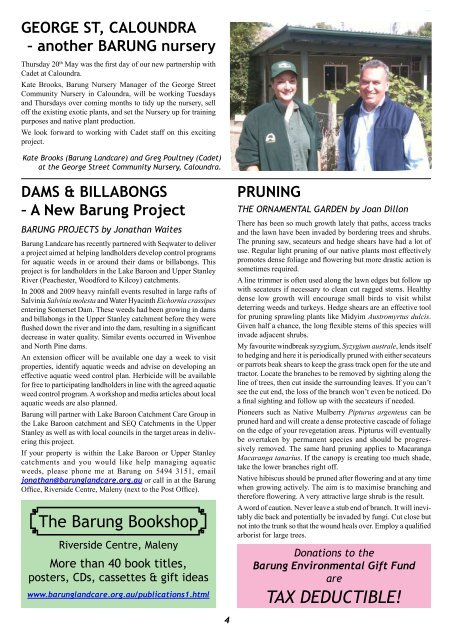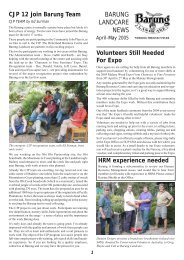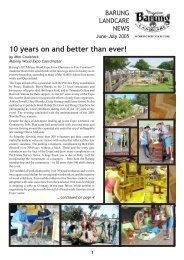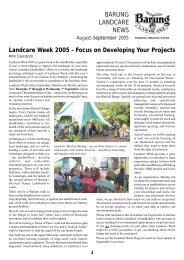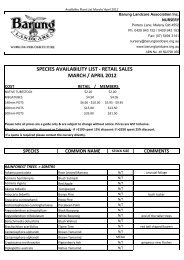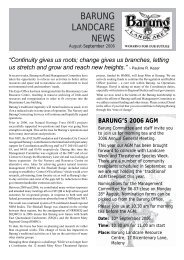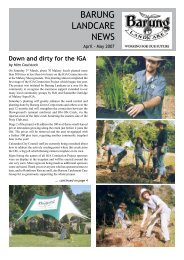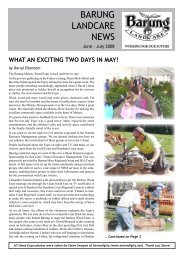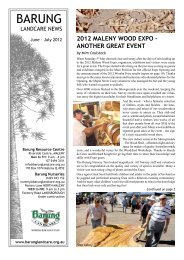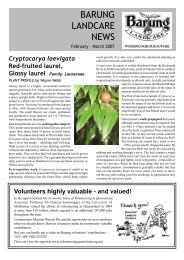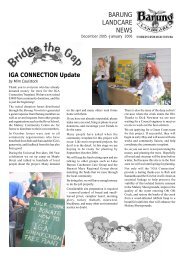Jun/Jul 2010 - Barung Landcare
Jun/Jul 2010 - Barung Landcare
Jun/Jul 2010 - Barung Landcare
Create successful ePaper yourself
Turn your PDF publications into a flip-book with our unique Google optimized e-Paper software.
GEORGE ST, CALOUNDRA<br />
– another BARUNG nursery<br />
Thursday 20 th May was the first day of our new partnership with<br />
Cadet at Caloundra.<br />
Kate Brooks, <strong>Barung</strong> Nursery Manager of the George Street<br />
Community Nursery in Caloundra, will be working Tuesdays<br />
and Thursdays over coming months to tidy up the nursery, sell<br />
off the existing exotic plants, and set the Nursery up for training<br />
purposes and native plant production.<br />
We look forward to working with Cadet staff on this exciting<br />
project.<br />
Kate Brooks (<strong>Barung</strong> <strong>Landcare</strong>) and Greg Poultney (Cadet)<br />
at the George Street Community Nursery, Caloundra.<br />
DAMS & BILLABONGS<br />
– A New <strong>Barung</strong> Project<br />
BARUNG PROJECTS by Jonathan Waites<br />
<strong>Barung</strong> <strong>Landcare</strong> has recently partnered with Seqwater to deliver<br />
a project aimed at helping landholders develop control programs<br />
for aquatic weeds in or around their dams or billabongs. This<br />
project is for landholders in the Lake Baroon and Upper Stanley<br />
River (Peachester, Woodford to Kilcoy) catchments.<br />
In 2008 and 2009 heavy rainfall events resulted in large rafts of<br />
Salvinia Salvinia molesta and Water Hyacinth Eichornia crassipes<br />
entering Somerset Dam. These weeds had been growing in dams<br />
and billabongs in the Upper Stanley catchment before they were<br />
flushed down the river and into the dam, resulting in a significant<br />
decrease in water quality. Similar events occurred in Wivenhoe<br />
and North Pine dams.<br />
An extension officer will be available one day a week to visit<br />
properties, identify aquatic weeds and advise on developing an<br />
effective aquatic weed control plan. Herbicide will be available<br />
for free to participating landholders in line with the agreed aquatic<br />
weed control program. A workshop and media articles about local<br />
aquatic weeds are also planned.<br />
<strong>Barung</strong> will partner with Lake Baroon Catchment Care Group in<br />
the Lake Baroon catchment and SEQ Catchments in the Upper<br />
Stanley as well as with local councils in the target areas in delivering<br />
this project.<br />
If your property is within the Lake Baroon or Upper Stanley<br />
catchments and you would like help managing aquatic<br />
weeds, please phone me at <strong>Barung</strong> on 5494 3151, email<br />
jonathan@barunglandcare.org.au or call in at the <strong>Barung</strong><br />
Office, Riverside Centre, Maleny (next to the Post Office).<br />
The <strong>Barung</strong> Bookshop<br />
Riverside Centre, Maleny<br />
More than 40 book titles,<br />
posters, CDs, cassettes & gift ideas<br />
www.barunglandcare.org.au/publications1.html<br />
PRUNING<br />
THE ORNAMENTAL GARDEN by Joan Dillon<br />
There has been so much growth lately that paths, access tracks<br />
and the lawn have been invaded by bordering trees and shrubs.<br />
The pruning saw, secateurs and hedge shears have had a lot of<br />
use. Regular light pruning of our native plants most effectively<br />
promotes dense foliage and flowering but more drastic action is<br />
sometimes required.<br />
A line trimmer is often used along the lawn edges but follow up<br />
with secateurs if necessary to clean cut ragged stems. Healthy<br />
dense low growth will encourage small birds to visit whilst<br />
deterring weeds and turkeys. Hedge shears are an effective tool<br />
for pruning sprawling plants like Midyim Austromyrtus dulcis.<br />
Given half a chance, the long flexible stems of this species will<br />
invade adjacent shrubs.<br />
My favourite windbreak syzygium, Syzygium australe, lends itself<br />
to hedging and here it is periodically pruned with either secateurs<br />
or parrots beak shears to keep the grass track open for the ute and<br />
tractor. Locate the branches to be removed by sighting along the<br />
line of trees, then cut inside the surrounding leaves. If you can’t<br />
see the cut end, the loss of the branch won’t even be noticed. Do<br />
a final sighting and follow up with the secateurs if needed.<br />
Pioneers such as Native Mulberry Pipturus argenteus can be<br />
pruned hard and will create a dense protective cascade of foliage<br />
on the edge of your revegetation areas. Pipturus will eventually<br />
be overtaken by permanent species and should be progressively<br />
removed. The same hard pruning applies to Macaranga<br />
Macaranga tanarius. If the canopy is creating too much shade,<br />
take the lower branches right off.<br />
Native hibiscus should be pruned after flowering and at any time<br />
when growing actively. The aim is to maximise branching and<br />
therefore flowering. A very attractive large shrub is the result.<br />
A word of caution. Never leave a stub end of branch. It will inevitably<br />
die back and potentially be invaded by fungi. Cut close but<br />
not into the trunk so that the wound heals over. Employ a qualified<br />
arborist for large trees.<br />
Donations to the<br />
<strong>Barung</strong> Environmental Gift Fund<br />
are<br />
TAX DEDUCTIBLE!<br />
4


